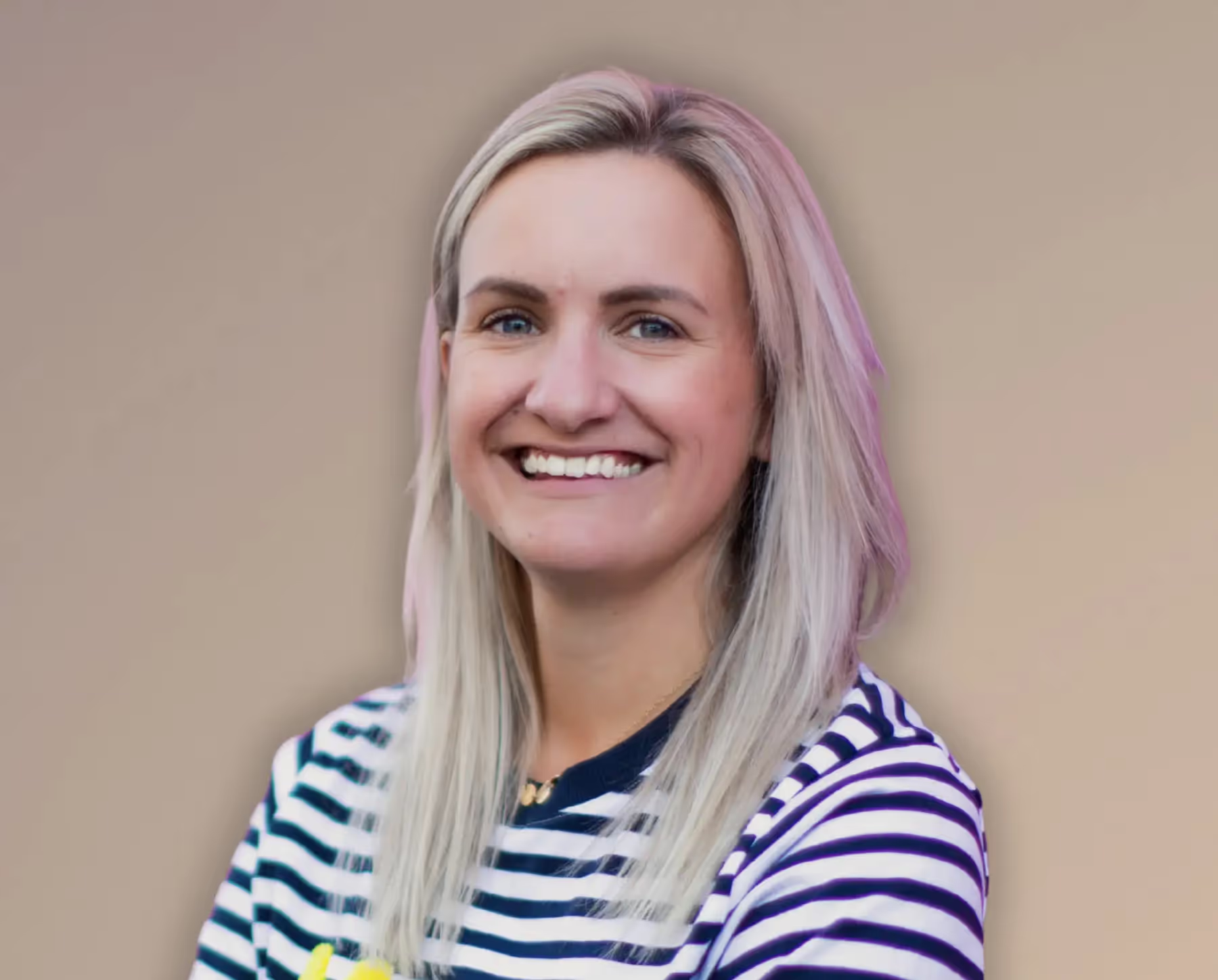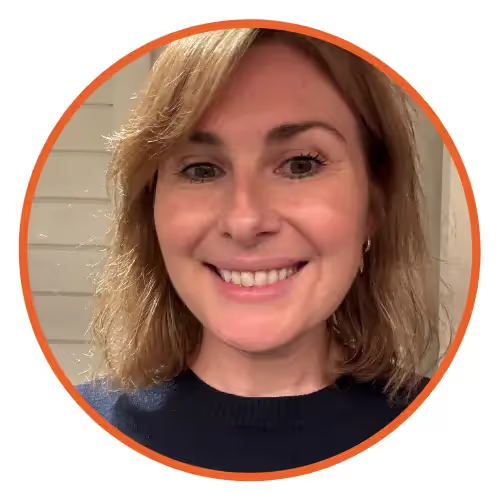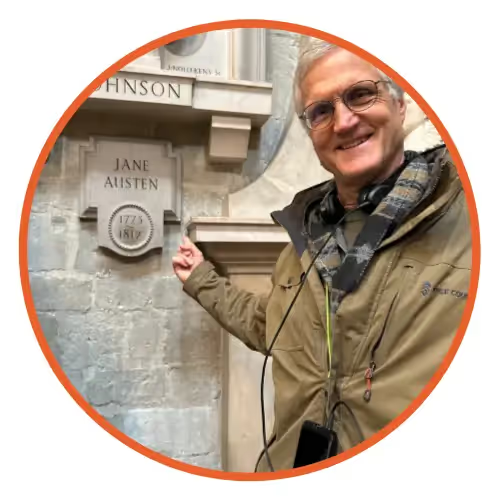

The Ninety Day Novel Class
Write your first draft






Fast-track your writing
Get that novel done in 90 days!
Whether you’re a complete beginner or an experienced writer, you’ll be given all the skills and tools you need to turn your idea into a brilliantly fearless first draft. Sign up for this exciting writing class to hold your novel in your hands!
Here’s where motivation meets method, and style meets substance. The proof is on the page, so let’s get started and put pen to paper.

A fresh approach to writing your novel
When you find out how easy it can be to write a book once you have the right tools, you’ll only wish you’d started sooner.
Discover:
- The big hack that will change your creative life
- The essential ingredient that makes a page-turner
- The one-word principle to creating drama that never fails
- The single characteristic great writers need, and how to nurture it
- The masterstrokes that give the reader those ‘aha’ moments
- How to banish bad writing habits
- The key to writing around your day job
- Your brand as an author
- The secrets of Nobel Laureates
- The fundamentals of storytelling. From genre, structure, plotting, planning and pacing, to the narrative arc, voice, tense, perspective, character, cast, sub-plots, and prose style.
And so much more…

Never found the right time to write your novel?
Maybe you just hadn’t found the right place. (Until now.)
Until now
Not all writing courses are created equal.
A great writing course has been created by an award-winning author. It comes from the horse's mouth. A great writing course has a proven track record of published success stories and enthusiastic reviews from real people. A great writing course will go beyond tired theories. It’ll help you make smarter progress, faster. A great writing course will:
- Teach tried-and-true techniques and invaluable skills.
- Put you on a defined path to publishing.
- Enable you to get your novel done. (And done well.)
- Introduce you to authors, publishing editors and literary agents at the top of their game.
- Welcome you to a global and supportive writing community.
- Offer a flexible approach, combining self-paced lessons and group classes.
- Include personal coaching sessions to tailor the lessons to your needs and develop your story your way.
- Ensure you hit the vital requirements of your genre and meet publishing standards.
With a great writing course you’ll get all the answers you require, the inspiration you want and the support you need to thrive. (A great writing school lives and breathes on the successes of it graduates.)
Write on your terms. At your pace. Your way. In good company.
You’ve come to the right place, because we grow writers.
Whether you’re just starting your journey, or are a little way along and need a guiding hand, this class is for you.
Our bestselling writing coaches are trained in helping you find your voice using our Positive Coaching Method®. But while The Novelry is renowned for being a safe, supportive and fun space, our classes mean serious business.
Forget the fluff. Our tools and techniques are proven to be successful.
The Novelry is where fledgling writers learn to fly.
So if you have the will, we have the way.
It takes just 90 days to form a habit.
We want you to become a prolific writer in a way that still works with the realities of your daily life. Our one-hour-a-day method is a tried-and-tested model for getting your first draft done no matter how busy you are.
We’ve seen many people write novels, and those who do best are those who are consistent.
But you know what? The majority of the storytelling process happens in the subconscious thinking hours you’re not at your desk. The hours spent walking the dog, taking a shower or sitting on the toilet.
If you water that novel daily for just one golden hour, the other 23 will take care of things, and you’ll have a manuscript in your hands in three months’ time.
That golden hour is 24-carat.
Never fear.
Our author and publishing experts let you know if your story has commercial value before you begin writing. This Story First Method® saves you a whole lot of time and trouble, so you can hit the page writing, with confidence.
Page-turners don’t happen by accident. They’re created. We reverse-engineer the process, starting with the hook or bestseller pitch, then build from the ground up.
You’ll learn the key ingredients required for readers to stay gripped to each and every word. And the secret sauce publishers are looking for. All before you even put pen to paper.
Our savvy makes for a story you can’t wait to unfold. And if you’re writing from the edge of your seat, chances are, your reader will be reading from the edge of theirs.
Not all writing courses are created equal.
A great writing course has been created by an award-winning author. It comes from the horse's mouth. A great writing course has a proven track record of published success stories and enthusiastic reviews from real people. A great writing course will go beyond tired theories. It’ll help you make smarter progress, faster. A great writing course will:
- Teach tried-and-true techniques and invaluable skills.
- Put you on a defined path to publishing.
- Enable you to get your novel done. (And done well.)
- Introduce you to authors, publishing editors and literary agents at the top of their game.
- Welcome you to a global and supportive writing community.
- Offer a flexible approach, combining self-paced lessons and group classes.
- Include personal coaching sessions to tailor the lessons to your needs and develop your story your way.
- Ensure you hit the vital requirements of your genre and meet publishing standards.
With a great writing course you’ll get all the answers you require, the inspiration you want and the support you need to thrive. (A great writing school lives and breathes on the successes of it graduates.)
Write on your terms. At your pace. Your way. In good company.
You’ve come to the right place, because we grow writers.
Whether you’re just starting your journey, or are a little way along and need a guiding hand, this class is for you.
Our bestselling writing coaches are trained in helping you find your voice using our Positive Coaching Method®. But while The Novelry is renowned for being a safe, supportive and fun space, our classes mean serious business.
Forget the fluff. Our tools and techniques are proven to be successful.
The Novelry is where fledgling writers learn to fly.
So if you have the will, we have the way.
It takes just 90 days to form a habit.
We want you to become a prolific writer in a way that still works with the realities of your daily life. Our one-hour-a-day method is a tried-and-tested model for getting your first draft done no matter how busy you are.
We’ve seen many people write novels, and those who do best are those who are consistent.
But you know what? The majority of the storytelling process happens in the subconscious thinking hours you’re not at your desk. The hours spent walking the dog, taking a shower or sitting on the toilet.
If you water that novel daily for just one golden hour, the other 23 will take care of things, and you’ll have a manuscript in your hands in three months’ time.
That golden hour is 24-carat.
Never fear.
Our author and publishing experts let you know if your story has commercial value before you begin writing. This Story First Method® saves you a whole lot of time and trouble, so you can hit the page writing, with confidence.
Page-turners don’t happen by accident. They’re created. We reverse-engineer the process, starting with the hook or bestseller pitch, then build from the ground up.
You’ll learn the key ingredients required for readers to stay gripped to each and every word. And the secret sauce publishers are looking for. All before you even put pen to paper.
Our savvy makes for a story you can’t wait to unfold. And if you’re writing from the edge of your seat, chances are, your reader will be reading from the edge of theirs.
Say goodbye to writer’s block. Gain confidence in your skills. Find your voice. Take control of that storyline. And write ‘The End.’
Get daily guidance and confidence-building coaching to plot and pace writing your novel from the first page to the last sentence...
The Ninety Day Novel is a uniquely designed step-by-step program that transforms the overwhelming task of writing a novel into a clear, daily practice rooted ina commercially viable writing craft.
Build your novel across 100 lessons from premise to polished draft, learning unique storytelling skills and advanced prose techniques. Writers are guided through theme, character, plot, setting, structure, and voice using our proven pathway to publishing success. It’s a powerful, expert framework that will teach you not just how to write like a literary star, but how to finish a novel in 3 months.
You will have access the class for a year to enjoy daily live writing sessions, classes and workshops, and The Ninety Day Novel class includes six personalized coaching sessions from a published, bestselling and award-winning author of your choice.
Every one an expert in their genre. Each trained in our Positive Coaching Method™. All rooting for you, and at your side every step of the way to help you develop your story to its full potential, ensuring you stay on track to finish that first draft.
Refresh your creative life with a fresh daily writing mindset and draft your first storyline with step-by-step guidance
Get feedback from your coach on your outline before you start writing
Write with a lesson a day and enjoy actionable feedback on the development of your story in your regular coaching sessions
Power through your lessons and enjoy live writing classes and workshops every week with your new writer friends
Develop new craft skills over the course of 100 lessons and celebrate your achievement with our community
The Ninety Day Novel Class
Prepare and develop your initial idea, construct your novel from the ground up, develop a productive writing practice, power through the middle with bold plotting, and raise the stakes toward a satisfying ending. Finish a first draft in 90 days with access to the writing class, your coaching and community for a full year.
The Inspiration and Preparation Phase
Discover the big hack that will change your creative life. Learn the one characteristic great writers need, and the essential ingredient that makes a page-turner. Boost your creativity, and receive guidance on creating the time and mental space to write around your day job.
✨ Welcome
Set the foundation for writing your novel with some espresso shot to boost your morale and get you in the flow. Kick some old habits with some unusual tips to change your state of mind to one that is positively refreshed and raring to write!
📚 Read and Be Inspired
Read what you want to write! Study first chapters to see how great novels raise questions they later answer. Focus on story over style. Use reading to quell doubt daily, and build your confidence. Keep notes and prepare questions for your coach as your story begins to take shape.
🌙 Bedtime Stories
Reconnect with the books that first stirred a desire to write. Reflect on the emotional imprint of your early reading. Writing begins with that same private charge. Let gratitude, not pressure, guide the work. The impulse to write is your longing to speak across time and space.
🔁 Habits
Design a writing life that fits your real one. Build a simple routine that anchors your writing at a regular time each day. Avoid waiting for inspiration—consistency is the source of creative energy. Frequency matters more than duration.
🧠 The Big Hack
Make a meaningful sacrifice to claim time for writing—something must go. Identify what you’ll give up to honor the work ahead. Interrupt the cycle of perfectionism by writing fast and free. Write by hand in timed sessions to bypass the inner critic. Speed lowers self-consciousness and unlocks voice. Capture raw material first—refinement comes later.
🔒 Privacy
Protect your work from feedback, judgment, or scrutiny while it’s still forming. Keep the process private to preserve freedom and courage. Don’t announce your novel or share early pages. Privacy is the condition for real discovery and risk.
❤️ Empathy
Build a character by stepping inside their experience. Begin with feeling, not facts—let your empathy lead. Treat your character as a mystery to discover, not a device to control. The better you understand their contradictions, the more truthful and compelling your story will be.
🌫️ Moods
Track your emotional state and work with it, not against it. Don’t wait to feel inspired—use your current mood as material. Keep writing through restlessness, boredom, or doubt. Show up. Let the act of writing transform your mood, rather than relying on your mood to begin.
🙏 Bless You, Writers
Recognize that writing has its complexities. You’ll face resistance, loneliness, and self-doubt—but writing is an act of generosity. Honor your need to create, and commit to it. Writing well means living well. Trust the process, protect your spirit, and keep faith with your story.
🧩 What is Story?
A story begins with change. It puts a person in jeopardy. Story is structure—not style—and it must change the character by the end. Plot isn’t decoration; it’s the engine that reveals who your character truly is capable of becoming.
The Construction Phase
Take it steady with step-by-step guidance to prepare a one-page plan that packs a big plot. Say goodbye to writer’s block. A good story (almost) writes itself, so you and your writing coach will put an exciting storyline in place to get off to a cracking start.
🧭 Lesson 1: How to stay on track with the course
Use the first 15 days to build your story—alternating between planning and early exploratory writing—before your full draft begins. Stay connected to your writing coach and submit ‘The Plan’ for feedback to keep your story development on track. If you’re rewriting, use this phase to reassess structure and elevate your idea. This is where you build the habit, commit to daily 60-minute writing sessions, and set yourself up to finish a first draft.
📖 Lesson 2: Welcome to your novel
Shape your novel’s premise by crafting a working title, a one-line pitch, and a promise to your reader. Start with something you know or care deeply about, then create distance by shifting time, place, or character to unlock perspective and theme. Identify your protagonist’s flaw and charm, then root your story in the voice and style of books you love. Keep refining the idea daily in your notebook—flipping it, challenging it, adding stakes—until it becomes a story worth the reader’s time.
🦸 Lesson 3: The Hero Book
Choose a single Hero Book to guide your novel-writing journey that offers a clear, reliable structure. Read it nightly to internalize its rhythm and shape. This book becomes your technical mentor, helping you solve story problems as you draft. It’s your companion for the next ninety days. Use it to support your structure, voice, and ambition.
⏰ Lesson 4: The golden hour
Build the habit of showing up daily for one hour to keep your novel alive in your subconscious. Even a light touch—reading yesterday’s work or jotting notes—feeds the 23 other hours of reflection that shape the story. Track-laying happens between sessions. Momentum comes from continuity, not volume. One hour is enough.
📚 Lesson 5: The genre
Understand what genre is and how it works. Learn how to use genre to define your story’s territory, structure, and reader promise. Explore examples across fiction to see how genre shapes plot, character, setting, and theme. Begin to identify the genre of your novel to give it coherence and direction.
🏔️ Lesson 6: The setting
Choose a time and place that shapes your characters, plot, and mood. Use setting to generate atmosphere, reveal character, or frame the story’s moral universe. Research real locations or build imagined ones that feel lived-in and essential to the story. For fantasy or sci-fi, create thresholds between worlds and combine the familiar with the strange. Make setting work as metaphor, emotional driver, and lens for your protagonist’s worldview.
🎩 Lesson 7: The magic trick
Build your story’s arc using the three-part structure of The Pledge, The Turn, and The Prestige. Shape your plot around a character’s transformation—what they want, what they resist, and what they become. Practice illusion through moral change. Sketch a journey that promises real stakes and delivers powerful, surprising resolution.
👤 Lesson 8: The main character
Design a character with a clear flaw, desire, and contradiction. Anchor the plot in their resistance to change. Focus on how they behave under pressure—not backstory, but present struggle. Build empathy by showing what’s at stake for them emotionally. Give them a worldview that will be challenged. Let the story test and transform it.
🧱 Lesson 9: The plot
Start shaping your plot by identifying the problem your main character must face. Learn how to use structure as a flexible guide, not a rigid map, by working back from a possible ending and sketching key complications along the way. Explore the ‘Man in a Hole’ story shape and other narrative trajectories to create emotional movement. Begin using The Plan—your one-page outline—as a working tool that responds to the writing. Focus on pressure, escalation, and change as you throw rocks at your character’s beliefs and force a reckoning.
🪜 Lesson 10: Simple story structure
Learn the foundational two-act structure—problem and solution—anchored by a midpoint that forces transformation. Use The Five Fs® to map your story’s arc: Flaw, False Hope, Flight, Fury, and Facing It. Understand how each stage reveals your character’s blindspot, trials, and growth. Study examples from contemporary fiction to see how this structure builds momentum and resolution. Begin sketching your own Five Fs to shape the outline of your plot, using this framework as a flexible, development-focused tool—not a rule.
🪝 Lesson 11: The hook
Create a sharp, one-sentence pitch that captures your novel’s premise, character, conflict, and stakes. Build it around irony—emotional, moral, or situational—to give the idea lift and twist. Learn the structure of a compelling hook: who it’s about, what they want, what’s in their way, and what’s at risk. Explore techniques from both literary and high-concept fiction, including the ‘X meets Y’ formula and the ‘What if...’ prompt. Use the hook to test your story’s power, motivate your process, and prepare for agent pitches, publisher sales copy, and submission success.
👥 Lesson 12: The cast
Build your cast by splitting your own traits into characters, then widen the net. Use parts of your personality—flaws, strengths, contradictions—to shape your leads. Add figures from your life with a twist: change names, genders, or roles. Invent with feeling, not revenge. Explore the ethics of representation and consider whose story you’re telling. Draw from lived experience or research with care when writing outside your own identity. Finish with a list of characters who offer dramatic potential and truth.
🥸 Lesson 13: Character development
Create credible characters by listing their quirks, flaws, fears, and secrets—then use those to reveal personality through action and dialogue. Skip backstory dumps by knowing each character deeply: their job, income, past loves, relationships, regrets, and what they want. Use a short list of 20 prompts to fast-track this work, unlocking plot and scene ideas as you go. Focus on the top five to ten characters and return to this exercise during slower writing days to keep the work moving. Characters drive story—start drawing them with precision.
🗂️ Lesson 14: Getting organized
Set up your writing environment and tools to keep momentum. Use folders to store drafts, character sheets, and notes. Keep a hard copy of your outline visible. Use your notebook to capture freewriting, ideas, and emotional responses. Track your scenes with a spreadsheet or calendar. Protect time with a daily writing schedule. Build a system that supports consistency and focus. Writing a novel requires discipline—your workspace and tools must help you stay clear, prepared, and committed.
🗺️ Lesson 15: The Plan
Create a one-page snapshot of your story to guide your writing and coaching sessions. Draft your hook, synopsis, theme, and the central question your reader will be reading to answer. Use this live document to shape your plot as you write—updating it often. Submit your Plan at least 24 hours before each session so your coach can track your development and help refine your premise. This working outline will clarify your structure, genre, and goals, becoming the backbone of your novel and a professional tool to move your idea toward publication.
✍️ Lesson 16: Let’s write!
Begin drafting, even if your story feels incomplete. Focus on daily progress—start with 250 words and build gradually. Use your updated Plan weekly to track changes, knowing your plot and character may shift as you write. Don’t share your draft yet. Protect your focus. Show up, write, revise, and keep going.
🧠 Lesson 17: Point of view
Choose between first or third person based on the story’s needs. Learn how first person creates immersion and unreliability—ideal for thrillers and character-led narratives—while third offers distance, breadth, and universality. Understand free indirect speech as a powerful tool to blend close perspective with third-person narration. Try your scene in different POVs to find the best fit.
🗣️ Lesson 18: Voice
Forget finding your voice—focus instead on speaking plainly and truly. Let voice emerge both from how you see the world and how you might address a smarter stranger. Good voice convinces by not trying too hard. Explore examples of relaxed, confident storytelling in action. Avoid fakery or flourish. Use understatement, guilelessness, and humor as your tools. The goal isn’t to impress—it’s to invite the reader in so they forget the writer is there.
🪟 Lesson 19: Chapter one
Learn why first chapters are never final—they’re rewritten dozens of times—and how even great writers fumbled their openings. Discover the importance of setting a calm, confident tone, introducing character and setting and piquing the reader’s curiosity. Focus on what your protagonist wants, hint at what they need, and begin with a grounded moment that reflects your theme. Write 250 relaxed words.
🕸️ Lesson 20: Character mapping
Design each supporting character with a moral arc that affects your protagonist’s development. Map their trajectory—how they change across the story—using simple moral shifts. Ensure each character throws ‘rocks’ at the hero to reveal flaws and create friction. Balance your cast across the moral spectrum and track their influence on the plot. Use The Novelry’s Four Types Method as a tool for close-knit groups. Once you know what each character wants and how they behave, you’re ready to write them scene by scene.
🧑🤝🧑 Lesson 21: Relationships
Build a dynamic web of relationships that define your protagonist’s moral arc. Learn to map each character’s role as helper or hinderer, anchoring your story in conflict and desire. Study triangular tensions and push-pull dynamics that generate dramatic momentum. Explore subplots by uncovering hidden motives and unspoken needs. Create a visual character map to clarify narrative pressure points and refine every scene. Let tension between characters shape your story’s energy, movement, and meaning.
👐 Lesson 22: Emotional strategies
Assign each major character a core emotional strategy—how they’ve learned to get love and attention. Choose from four core types: the Savior, the Flower, the Hero, and the Recluse. Observe how this ingrained tactic shapes their relationships, drives their dialogue, and triggers conflict. Use this lens to enrich character interactions, heighten tension, and create psychological credibility. Characters may moderate or switch strategies depending on the scene, but one dominant ploy should underpin each principal’s behavior.
🌳 Lesson 23: The theme
Test every story element—setting, cast, and plot—against a central thematic tension: what argument is the novel making? Explore conflicting values in your characters to dramatize this tension, placing your protagonist at the center of a tug-of-war. Use bold statements like ‘X is more likely than Y’ to guide your choices. Add your working theme to The Plan.
💓 Lesson 24: The heart of a story
Find the emotional truth at the center of your novel—a moment of vulnerability, connection, or personal reckoning that carries moral weight. Begin with a private dedication to someone who embodies what matters most to you. This becomes your compass. Let your heart lead the writing, drawing from love, loss, and care to shape meaning for the reader. Select a guiding quote or song to anchor your intent. When you write from feeling, the reader feels it too. That’s the story’s purpose: to make us care.
🕊️ Lesson 26: The sacrifice
Explore sacrifice as the measure of commitment in story and life. Learn how great stories—from ancient myth to The Alchemist—use sacrifice. Understand its central role in the Hero’s Journey, where the protagonist gives up comfort for a greater purpose. Discipline reveals strength. This lesson invites a deeper connection between writer and story, asking what your characters are willing to lose.
🔨 Lesson 27: A better craftsman
Step back from the page and assess your work. Re-read your recent writing to identify weak scenes, tired phrasing, and moments where plot, dialogue, or tone drift off-course. Revisit your Plan, revise it if the story has shifted, and tighten your cast’s motivations. Root out clichés. End each chapter with a tease. Let the prose be plain to support the story’s truth. Shape your material—but don’t overwork it. Today, write as an editor.
🖼️ Lesson 28: The big picture
Visualize your story as a sequence of six turning-point scenes, using cinematic techniques to clarify structure and momentum. Identify your protagonist, goal, antagonistic force, and stakes. Then build a visual storyboard using notecards or tools like Canva to map transitions and flesh out scenes. Each location must earn its place.
🎬 Lesson 29: Happy writing
Learn how to work through self-doubt, navigate real-life interruptions, and make meaningful progress scene by scene. Discover proven mindset strategies from working writers—including how to embrace the rhythms of good and bad writing days, stay grounded in real life, and use your Hero Book to problem-solve at night. Leave the desk on time, avoid early fiddling, and trust the day-to-day process.
🧮 Lesson 30: Taking stock
Pause to review progress before moving to the next phase. Use the stocktaking spreadsheet to chart chapter-by-chapter word counts, setbacks, and lessons learned. Update The Plan as needed and reflect on how far you’ve come. If you feel off-track, schedule time with your coach. Whether slow or fast, the point is to keep going. This is a victory lap before the next leg: The Swim.
The Swim Phase
Learn expert skills and insider techniques to quickly improve your writing style. Find your voice and build your confidence as your word count passes the 10,000-word mark.
🏊♂️ Lesson 31: In the swim
Enter the Swim Phase—a shift from story set-up to story flow. Revisit the simple five-part structure to sketch out the story shape without over-planning. Learn how Kazuo Ishiguro wrote The Remains of the Day in just four weeks using ‘The Crash’: a self-imposed writing lockdown focused on output, not polish. Learn how compulsion drives story. When a character wants something intensely, the novel almost writes itself. This phase is about rhythm, grace, and pace. Begin writing forward with daily momentum and character-led intent.
🧭 Lesson 32: Moral range
Explore your protagonist’s capacity for action under pressure by mapping their moral range. Define what they can and can’t do, and identify the lie they live by that distorts their worldview. Use this to create tension scene by scene—especially as the story shifts from old world to new. Know when to press the button—what they’ll do when cornered—to drive story turns and deepen emotional impact.
🔥 Lesson 33: Compulsion
Pinpoint your main character’s compulsion—the hidden need that drives their actions, blinds them to truth, and fuels the story’s engine. Learn how desire, denial, and delusion work together to create narrative drive. Explore how this inner hunger creates moral tension and raises stakes. Repressed or transgressive compulsions create page-turning drama. Use moral range and inner conflict to expose the character’s organizing myth and push the story toward revelation, transformation, or downfall.
🎭 Lesson 34: Conflict
Build conflict that reveals theme. Let your protagonist and antagonist pull from opposite ends of a moral or emotional spectrum. Use tension to test values, surface hidden agendas, and create moments of rupture that shape character and story. Design the moment of greatest conflict so that it dramatizes the central question of your novel and forces change.
🪄 Lesson 35: From magic to mystery
Let the mystery deepen as your draft develops. Shift from plotting answers to posing questions—what the reader is reading to find out, and what you’re writing to discover. Use the one-page plan to hold structure lightly while staying open to surprise. At the two-thirds mark, allow meaning to emerge—private, profound, and unspeakable. Write to learn what haunts you. Let mystery drive the story forward.
📚 Lesson 36: How to write a cult classic
Borrow Jack Kerouac’s methods to create immersive, character-led fiction with lasting impact. Study his use of real people, not types, and mimic his overfamiliarity, fast prose, and vivid detail to convey immediacy. Learn to write with pace and presence—using observation over exposition—to give the illusion of spontaneity. Use these techniques to produce bold, idiosyncratic work.
🎭 Lesson 37: A real dream
Master the technique of ‘show, don’t tell’ by using concrete sensory detail and true-to-life dialogue to immerse the reader. Learn how to build scenes that feel vivid while still knowing when to step in and tell. Explore how Kerouac’s prose reveals the power of language to reflect emotion, and where pure ‘showing’ can fail.
🫂 Lesson 38: Assumed familiarity
Learn how assumed familiarity can immerse the reader instantly—bringing characters to life without formal introduction. Study how Kerouac uses eccentricity, catchphrases, and vivid, selective detail to distinguish a large cast. Use tics, colorful backstories, and out-of-type traits to avoid stereotypes and animate even minor characters in a few bold strokes.
👑 Lesson 39: The romantic imagination
Explore how the author Muriel Spark used fiction to exalt the romantic imagination over realism, building an authorial approach of taste, sensibility, and theme. Learn how to channel your own aesthetic convictions into character and story, free from convention. Discover how to make the uncommon feel true, how to embed meaning through voice and tone, and how to use fiction to reframe reality.
🔁 Lesson 40: The use of repetition
Use repetition to build intimacy with economy. Establish character through repeated phrases or gestures. Repetition keeps the reader’s eye on the cast while you advance theme. Deploy signature catchphrases that echo the novel’s central question, like a red ball bouncing across the story. Don’t repeat themes directly—repeat character affectations. Later, in the edit, you will trace this coded pattern through every page to sharpen focus and create a story that keeps readers turning pages.
♻️ Lesson 41: Redemption
Explore how great fiction offers moral restoration—not through absolution, but through affection and time. Learn how to use the redemptive arc to shift your character from what they want to what they need. Study the technique of flash-forward to deliver a sense of earned perspective. Redemption can be quiet or spiritual, structural or thematic. Understand how even flawed characters can be forgiven, and why good writing must grapple with grace.
🥛 Lesson 42: Keep it simple
Streamline your story by asking: whose story is this, what do they learn, and how do they change? Reduce characters, settings, and complications that aren’t essential. Troubleshoot problems like weak conflict or a protagonist too close to yourself. Use quick fixes—change gender, background, or name—to create distance. Anchor the plot in present conflict, not backstory. The goal: a clean, energetic through line.
✂️ Lesson 43: Overwriting
Learn how to cut overwriting before it sabotages your story. This lesson shows how bloated prose—didactic tangents, tired set pieces, excess emotion, and decorative adverbs—slows your pace and distances readers. Study examples from Hemingway, Baldwin, Morrison, and Walker to see how great writers use restraint. Apply three core techniques: trim adjectives and adverbs, reduce description to pinpointed detail, and shorten sentence length. Good writing leaves space for the reader.
✍️ Lesson 44: Becoming an author
Start working like a professional preparing for publication. Learn how to format your manuscript correctly—spacing, punctuation, paragraphing, and chapter layout all contribute to how the reader receives your work. Adopt a consistent file naming system, save drafts daily. Use a clean, conservative layout to earn trust before your story delivers the surprises. This lesson sets the standards that separate the aspiring writer from the working author.
📍 Lesson 45: The midpoint
Pinpoint the exact moment when your character can no longer go back—the midpoint of the novel. Identify the event or crisis that forces a shift in strategy, where their old ways fail and a new outlook begins. Show how they absorb qualities of their antagonist, confront hard truths, and begin their transformation. Update The Plan with this turning point, anchoring it in theme and character arc. This lesson crystallizes your story’s change trajectory—what they wanted was wrong; now it’s time to fight for what they need.
The Heat Phase
Here’s where you fall in love with your story. Banish bad habits and keep your eye on what the reader wants to stay on track with your plot. Discover some game-changing writing power tools, and raise the stakes in your story.
🎵 Lesson 46: Music
Use music as a tool to charge the energy and rhythm of your writing. This lesson introduces a new creative phase—The Heat Phase—focused on boosting pace. Learn how instrumental music can lift your prose and how lyric-driven tracks can teach economy. By the end, you’ll build a writing practice rooted in pace and feeling.
🔥 Lesson 47: From What If to Why?
Shift the driving question of your novel from ‘What if?’ to ‘Why?’ to deepen plot and character. Refine the core reader question using Maslow’s hierarchy of needs—starting from physical survival and safety to love, esteem, and purpose. Study how bestselling novels sustain tension through a single, evolving question. Use your character’s willful refusal to meet basic needs to create dramatic intrigue. Craft a story that plays on human behavior, digging into what your character won’t do—and why. A great novel hinges on one bold, burning question.
🧵 Lesson 48: The B Story
Construct a subplot that amplifies your novel’s theme and throws the main character’s journey into sharper relief. This secondary storyline should represent the opposite value system or outcome—embodied by a standout secondary character—and bring it into conflict with the ‘A’ plot. Study how published novels use B Stories to heighten stakes and expose the moral consequences of your protagonist’s choices. Decide where this subplot will peak, ensuring it helps your hero reject the extreme and claim their own way forward.
🤥 Lesson 49: The lie
Find your novel’s core message by identifying the lie it reveals. Lies generate conflict, fuel suspense, and distort desire—whether personal, political, or cultural. Use examples from Orwell, Du Maurier, and Coetzee to examine how theme emerges when falsehood is exposed. Reframe character motivation by showing what they believe that isn’t true, and structure your novel as a journey from illusion to truth. Learn how to embed the lie in dialogue, catchphrases, and chapter turns to heighten dramatic stakes.
🧌 Lesson 50: I’m a creep
Use your shadow self to unlock honesty in your writing. Identify your flaws, contradictions, and moral complexities. Practice observing your darkest instincts, then shape them into your protagonist’s turning point. Keep a visible list of problems as they arise in your draft; naming them unlocks solutions. Learn to slow narrative time around self-revelation moments, as Colm Tóibín does, to give moral insight weight and emotional clarity.
😨 Lesson 51: Suspense
Build suspense by withholding information and creating unease. Study how Rebecca and In a Dark, Dark Wood use repetition, contradiction, and delay to disorient and tease the reader. Use short chapters, flashbacks, and emotionally charged contrasts—hot/cold, light/dark—to keep tension rising. Assign a ‘trigger word’ to each chapter and increase its danger over time. Withhold answers until after the midpoint, when the worst thing must happen. Suspense is built on uncertainty—what the reader fears is more powerful than what they know.
🔧 Lesson 52: Make it harder
Raise the stakes. Impose constraints to sharpen your writing: shorten chapters, limit word counts, or apply a ticking clock. Increase external pressure on your main character—cut resources, add danger, create urgency. Tight structure boosts pace, and hard limits force invention. The harder the context, the more potent the message.
💬 Lesson 53: Crackling conversations
Write dialogue that feels alive and loaded with intent. Learn how to craft character agendas, cut exposition, and leave space for subtext. Discover how to avoid dull ‘ping-pong’ exchanges and use silence, refusal, or abrupt exits for tension. Explore why contractions, clipped speech, and differentiated voices make dialogue real. Master clean tags, minimal adverbs, and active scenes that reveal character beneath the lines. This is where dialogue starts doing real narrative work.
🧠 Lesson 54: That’s peculiar!
Learn how to write with dissonance—deliberately placing details that don’t fit. Study the masters of the short form, like Chekhov, Carver, and Hemingway, to sharpen your ability to show what jars instead of what explains. Use visual discord to jolt your reader’s perception and invite emotional depth without melodrama. Highlight sensory oddities and peculiarities that spark vivid immersion. Choose standout details that linger in the mind. Let your prose be unexpected, strange, and true.
🎵 Lesson 55: The leitmotif
Discover how a light recurring detail—like a phrase, image, or object—can build continuity, add depth, and create intimacy between writer and reader. Explore the difference between heavy-handed symbols and subtle echoes that function like a shared in-joke or chorus. With examples from Vonnegut, Kundera, and Forster, learn how to thread a small motif through your novel to highlight emotional themes, mark time, and anchor meaning without exposition.
🐇 Lesson 56: The absurd
Introduce the irrational into your novel to deepen realism and resonance. Draw from Camus, Kafka, and Vonnegut to explore characters in conflict with a meaningless world. Use contradiction, bathos, and surreal events to mirror existential truths. Give characters odd behaviors or false beliefs and unlock humor in tragedy. Absurdity lets your story bypass logic to process pain. Add a comic wrong note! Let the bizarre do the lifting.
✒️ Lesson 57: The full stop. Period.
You will study Raymond Carver’s radical economy of style to understand the emotional power of clean, unadorned prose. Learn how to end scenes and chapters with impact using the ‘dying fall’—a literary technique that creates an introspective pause in the reader. Use punctuation, silence, and space to invite the reader in. Then stop. Let them think.
🍋 Lesson 58: Backstory
Minimize backstory to keep momentum and preserve immersion. Avoid explanatory digressions and let the present action reveal character and history. If background must be included, use it sparingly, incompletely, and only when it advances the story. Prioritize mystery, pacing, and sensory detail over explanation. Draft a private inventory of essential backstory in your notebook—then leave it out.
🔀 Lesson 59: Transitions
Learn how to shift between timelines or perspectives while maintaining the progress of the story. Structure each timeline to serve the story and anchor transitions with mirrored images or echoed prose. Study structural examples—from Slaughterhouse-Five to Revolutionary Road—to master seamless cuts and purposeful contrast. Build dual narratives that interact meaningfully. Whether alternating chapters or blending timelines inside scenes, use each shift to reveal character truth and deepen the theme. Transitions must feel inevitable, not mechanical.
🏅 Lesson 60: The prize
Consider what success means for you and this story. Visualize the prize—awards, impact, personal fulfillment—and use that vision to fuel your writing. But weigh it against the price: solitude, vulnerability, and the need for validation. Don’t show or share your draft yet. Keep your vision intact and stay focused on momentum. Book a coaching session. Let the writing be its own reward.
The Enlightenment Phase
Using the inside secrets of a Nobel Laureate, you’ll apply new masterstrokes to fulfill the promise of your story. Discover the deft and economical touches that give the reader those ‘aha’ moments, and see the proof on the page that you’re mastering the skills of the craft.
🧘♂️ Lesson 61: Mastery
Enter The Enlightenment Phase by studying a master at work—Nobel Laureate, J.M. Coetzee. His novel Disgrace becomes your blueprint for serious fiction. Embrace slow, scrutinized craft. Discover moral sleight of hand, structural control, and linguistic precision. Learn how personal wreckage becomes literary gold. Through his example, start to treat your fiction as both the lighthouse and the rock using exposure, self-revelation, and sacrifice.
🤯 Lesson 62: Difficult questions
Learn from the painstaking process of J.M. Coetzee to embrace uncertainty. Discover how doubt, revision, and slow accumulation work for your craft. Writing isn’t about having answers—it’s about asking hard questions. Use notebooks to track your progress, explore your insecurities, and gather material.
🔪 Lesson 63: Self-destruction
J.M. Coetzee strips identity to its core in Disgrace, creating fiction through radical self-erasure. Explore the relationship between self-sacrifice and narrative power, where character and author collide in philosophical confrontation. See how the writing becomes an ethical act—an unflinching confrontation with shame. Writing at this level demands internal conflict. By witnessing Coetzee’s willingness to burn down the house of self, understand how fiction can become an act of creative destruction—yielding a story of brutal grace.
🏷️ Lesson 64: The title
Explore how a novel’s title encapsulates its magic, the agent of change. Study examples from literature that use eponym, image, juxtaposition, or reference. Test titles against your story’s meaning and evolution. Use this lesson to begin generating titles that capture the premise of your story at its core.
🩸 Lesson 65: The wound
Explore how personal loss fuels fiction. A wound—both authorial and fictional—drives a character’s compulsion. Understand how to write from suffering without sentimentality. Use this lesson to identify the wound in your own story and main character, to give your novel emotional integrity and transformative powers.
🌉 Lesson 66: The bridge
Revisit your opening sentence as your draft progresses—it should beckon the story’s end. Use your first line to seed paradox, establish theme, and set the reader’s expectations. Track how character and language evolve through re-drafts. Write a ten-word sentence that captures your protagonist’s dilemma.
👣 Lesson 67: Back and forth process
Embrace the messy motion of drafting—give yourself to the writing, then step back to question and refine. This lesson draws from J.M. Coetzee’s 17 drafts of Disgrace to show how great work emerges from doubt, persistence, and craft. Learn to navigate the discomfort of not knowing, and trust that taste and judgment are sharpened by failure. Use the first draft to explore freely—there’s time to look smart later.
⏳ Lesson 68: Present tension
Explore the dramatic force of the present tense. Learn how it creates instability, complicity, and immediacy by removing the safety of hindsight. Through examples like Disgrace and The Color Purple, see how present-tense narration drives moral urgency and places the reader inside the character’s crisis. If your prose feels flat, consider testing a tense change—even late in draft one.
💻 Lesson 69: Poet and programmer
Write sentence by sentence with the dual precision of a programmer and the emotional depth of a poet. See how structure emerges from theme, and how rhythm becomes a literary device. Discover how prose can carry musicality, and how writing becomes a form of self-navigation. Build meaning and movement, advancing line by line, like code.
🕰️ Lesson 70: The chapter outline
Create a working chapter-by-chapter outline to clarify the structure and pacing of your novel. Use it to map intentions, identify gaps, and simplify where needed. Study Coetzee’s Disgrace for a model of formal, purpose-driven structure: 24 chapters, each self-contained, each building tension and meaning. Focus on progression and economy—state your purpose, fulfill it, and move on. Use the outline to track your story’s momentum and ensure every chapter earns its place.
🌿 Lesson 71: Let them live
Free your main character from backstory and let them step forward. The best characters contradict their traits, hold true and false beliefs, and surprise both writer and reader. Write with paradox. Leave room for ambiguity at the end, allowing your novel to cast a longer shadow.
🎭 Lesson 72: The point of tragedy
Examine how tragedy operates as a vehicle for truth. Learn Aristotle’s three essential components—hamartia, peripeteia, and anagnorisis. Understand how tragedy evokes catharsis, forces reckoning, and offers the writer a deeper path to meaning. Study the five-stage structure of tragic narrative. Discover how writing reveals what you want to say—and how tragedy delivers truth through emotional disasters.
💖 Lesson 73: What is good?
Explore how great fiction transcends simple notions of good and bad to confront moral ambiguity. Using Disgrace by J.M. Coetzee, learn how visionary states like hypnagogia deepen your protagonist’s self-awareness and enrich narrative meaning. Trace David Lurie’s arc from egotism to humility, observing how memory, vision, and anagnorisis (tragic recognition) shape his internal reckoning. Discover how grace—not goodness—offers the novelist a more radical aim.
❓ Lesson 74: The big question
Refine the question driving your story by identifying what the reader is reading to find out—whether it’s whodunnit, will they get the prize, or who is this person really? Study how this central question can shift mid-novel, as in The Talented Mr. Ripley or Disgrace, evolving as character, setting, or theme develops. Use the question as both narrative engine and moral lens. Establish it clearly, revisit it often, and make it deliver personal transformation for both character and reader.
📘 Lesson 75: The story so far
Review the full arc of your novel and draft a working synopsis that captures your story’s potential without getting bogged down in imperfections. Use this moment to regain purpose and re-engage with your characters’ journey. If needed, book a coaching session and update The Plan. This is your opportunity to reframe the work, strengthen the through line, and prepare to carry the story forward to the end.
The Home Phase
Combine the key elements of storytelling and see theme, character, dramatic irony, narrative arc, and subplots working in harmony for a satisfying ending. Get advice on taking this draft to publishing standards. And then celebrate! You’ll have a manuscript in your hands and a story readers will love.
🏠 Lesson 76: Welcome home
Review the final structure and make adjustments to ensure the story is sound and grounded. Contrast your main character’s initial façade with their new self to clarify the novel’s arc. Use dream imagery and metaphor to explore how personal symbols, memories, and meaning can enrich your story. Prepare a sketch of the ending. Use the subconscious signals—night thoughts and dreams—that will now help finish what you’ve built. The home stretch begins here.
🪜 Lesson 77: Let’s build
Assign your existing chapters to the Five Fs framework rooted in classical tragic structure. Use this scaffolding to make sense of your draft and prepare it for a strong finish. Reorder material, if needed, to clarify escalation and transformation. Whether your chapters are short or long, give each a place in this sequence. Begin shaping your ending. This final phase is about making the book inhabitable—for you and your reader.
🏛️ Lesson 78: The house of magic
Use music and hypnagogic recall to explore each emotional stage of the story as a space: a messy front room, a closed bedroom, a blocked escape, a chaotic kitchen, and a bathroom of reckoning. Revise your Plan and schedule a coaching session to align story shape and character change as you approach the ending.
🛁 Lesson 79: The rooms
Plan your chapters as spaces within the larger structure of the house of your novel. Avoid episodic drift by ensuring that every chapter flows naturally from the last. Cut anything that doesn’t build both the psychological interior and action-oriented exterior.
🎨 Lesson 80: Interior style
Raise the standard of your writing by setting a higher bar for every sentence. Evaluate every line: is it necessary, true, distinctive? Create contrast: plain-speaking can sharpen the impact of strangeness. Build toward beauty and power by making each sentence count.
🏺 Lesson 81: Ornaments
Lend your novel the personal, the things that bring you comfort and joy—objects, sounds, and memories that mean something you. Scatter these ‘ornaments’ through your characters’ homes, names, and dialogue to build a world that feels lived-in. Choose names with meaning, add leitmotifs with private significance, and shape a place rich with emotional texture.
🧳 Lesson 82: The attic
Learn how to use memory as a narrative space distinct from backstory—the ‘attic.’ This is where you and your main character explore forgotten emotions and formative impressions. Use this mental storehouse to create atmospheric revelations that unfold in real time. The attic holds what’s unsaid. Return to it in moments of reckoning or reflection, and draw from its contents to deepen intimacy in pivotal scenes.
🧼 Lesson 83: Housekeeping
Expect messy days—when life disruptions knock you off track. Learn how to recover from derailment without spiraling. Use your notebook to make quick notes instead of forcing bad writing. Trust your original Plan and cut what doesn’t serve. Avoid writing about real-life grudges—they destabilize tone. Prioritize stability, repetition, and time over novelty. Build a quiet, protective routine around your process. Keep the novel safe, warm, and clean from inner sabotage.
🛏️ Lesson 84: And so to bed
Craft an ending that opens, rather than closes, a window. Examine famous last lines that spark mystery, and understand how a question (rather than plot closure) becomes your final gesture. This lesson encourages a subtle tying of threads, not a tidy bow—space for reflection and peace for the protagonist. Reflect on your own season as a writer, and let the novel go when the ideas stop coming. Complete your draft knowing it’s whole—for now.
🪑 Lesson 85: Home alone
Writing reveals more than it tells—what you’ve put on the page may expose more of you than intended, even behind fictional distance. Don’t seek outside opinions yet. Stay inside the work. Keep the mystery intact. Discover what this draft says about you, and decide how far into yourself you’ve truly gone. Resist the urge to share. The story has found its voice—and you may need to sit with it.
🚑 Lesson 86: First aid kit
Receive your collection of best writing tips from master writers. Use these as a personal survival guide for when the doubt creeps in. Explore the complete set of insights from published authors at The Novelry. Discover what they unanimously agree matters most. This lesson is a writer’s emergency kit for staying the course and finishing strong.
🏁 Lesson 87: Leaving home
Pause before editing. Set the manuscript aside for at least a month to gain the distance required for ruthless revision. Use that space to sharpen your judgment, stay curious, and strengthen insight. Then, revise with attention to your novel’s opening. Is the dilemma clear? Is the compulsion strong? Does it reflect the theme and arc? Make sure the story arises from character, offers transformation, and delivers what the reader needs.
📔 Lesson 88: The second draft
Step back for a month before beginning your second draft. Use the break to read recent novels in your genre, experiment with ‘sideways writing,’ and sharpen your hook. Revisit your story with distance, ready to reshape it with clear eyes. Draft a revision plan—consider chapter structure, themes, and stakes. Prepare for The Big Edit, where you’ll receive expert editorial support to transform your draft into a submission-ready novel.
🏆 Lesson 89: Success
Define success on your own terms before seeking it in publishing. Discover how to stay grounded through setbacks, resist the lure of fame, and preserve your joy in writing. Learn to process rejection without ego, and build resilience with humility and kindness. Find inspiration in James Baldwin’s philosophy. Prepare for revision with The Big Edit and know that real success lies in loving the life and work of a writer—and you’ve got that, and a killer process, in the bag!
🎉 Lesson 90: Congratulations!
Celebrate! You’ve built the habit, learned the craft, and shaped a novel only you could write. Acknowledge the discipline it took to get here. Download your certificate, share the news, and put your feet up. This milestone is now a happy and significant moment in your new life as a writer, writing.
Plus genre-specific lessons, mini courses in memoir and children’s fiction, and resources.
Authors mentioned in the course include: Jane Austen, Donna Tartt, Kazuo Ishiguro, Stephen King, Raymond Chandler, Patricia Highsmith, Daphne du Maurier, Gillian Flynn, George Saunders, Kurt Vonnegut, Shirley Jackson, F. Scott Fitzgerald, Rachel Cusk, Sally Rooney, Ian McEwan, Emily Brontë, Zadie Smith, Toni Morrison, Jean Rhys, Carson McCullers, Charles Dickens, Agatha Christie, Ernest Hemingway.
Your course certificate
‘A bird doesn’t sing because it has an answer; it sings because it has a song.’
‘Whether by chance or design, I completed my novel on the 90th day after beginning The Ninety Day Novel. Without this course, I have no doubt the work would be significantly poorer and only half completed. The course has an uncanny ability to provide material at the precise moment roadblocks and concerns emerge in the writing. The course is not only full of great writing advice, it delivers not just theory but a real novel at the end of it.’

Why The Ninety Day Novel Class?
Access to one-on-one coaching from bestselling authors
The brightest lights are at The Novelry.
Story First Method™
Understand whether your story has commercial value and is fit to excite publishers and agents.
Video masterclasses
From the likes of Kristin Hannah, Tayari Jones, and Yann Martel, and advice from publishing professionals and literary agents.
More 5-star reviews
Than any other writing course. The Novelry is the world’s top-rated fiction writing school.
A clear path to publishing
Yours if you want it. Fine if you don’t. We will help you reach pro standards.
Ready, steady, write!
The Ninety Day Novel Class








- Membership (1 Year)
- The Ninety Day Novel Class
- 6 Coaching Sessions
- A Year’s Access
The Finished Novel Course








- Welcome Call
- Membership (1 Year)
- The Classic Storytelling Class
- The Ninety Day Novel Class
- 6 Coaching Sessions
- The Big Edit Class
- 2 Editorial Sessions
- The Ultimate Manuscript Assessment
From creating your story then writing a polished draft, to publishing your bestselling book. Our writing classes and courses support you across the whole journey.
View all courses
FAQs
If you’re bursting with questions we haven’t answered here, check out our full FAQs page or feel free to get in touch.
In this self-paced writing course, you will enjoy over 100 lessons with videos and text giving you guidance as to what to do on the day of your writing. You’ll be guided step-by-step within the course and be served downloads and tools at just the right time for the development of your story. Besides your writer coaching, you’ll enjoy the support of the online community, and be able to join us for live weekly writing classes suitable for all writers and regular online workshops for those at every stage of their writing, in every genre.
You can take the courses at your own pace. We suggest one lesson a day, which will take from 20–30 minutes. You have immediate access to all lessons. We’ll share with you our ‘One Hour a Day’ method. All the ‘heavy lifting’ of creative development happens during the rest of the day as you consider what the lessons bring to your story. Flashes of genius will come to you in the shower or at the shops! You’ll race to your writing every day to get them all down. It’s one hour just for you and you’ll come to love this special time. One hour? You deserve it.
A notebook, a pen, and a computer with a decent internet connection for use of our online learning platform and coaching sessions.
Our online learning platform is easy to use, even for the less tech-savvy among us. We are supportive and responsive to our writers, available by email and at our online members’ community around the clock, worldwide, so that you can relax and enjoy your writing.
Your coaching begins after the first week of The Ninety Day Novel.
Before your first coaching session, we’ll guide you on how to create an outline for a novel. You’ll be nudged in the course to use our interactive tool to submit that to us (on a regular basis as you develop your story). We’ll look at your planned storyline as a team, and if we think another writing coach would be best suited to your story, we’ll drop you a line, but you’ll be able to make the final decision (and can always swap coaches later if you wish). One of the perks of The Novelry is that because our systems and records allow us to stay on track with your story development, it makes hand-off between coaches seamless so that you can work with any writing coach you wish and benefit from advice from experts across the fiction and memoir genres.
Every writing coach reviews your storyline in advance of the session via the interactive tool we call ‘The Plan.’
Your first coaching session begins with your writing coach understanding your intentions and aspirations for your book and writing career. That’s your brief to us, and allows us to give you the dedicated and personal guidance and support you need to achieve your ambition.
The coaching sessions are 45 minutes online, and you’ll find that’s plenty of time to get help with story development and troubleshoot any problems to stay on track with your writing. All sessions are recorded for you to keep. You may schedule your coaching sessions whenever you wish during your year with us and will be able to browse our diaries to select a time that works for you, in your time zone. Some like to stay on track with a coaching session every two weeks of their writing period, for example, and others like to pace themselves with one a month or get more help up front or more guidance and advance later on. You can get the support you need when you need it.
During the writing of a first draft, our focus is on your storyline, and we work with you to creatively develop and expand the story together, reviewing development in every session and answering your questions for your story.
You can, additionally, book Feedback Sessions which include a report and a live Zoom debrief; see below. We suggest you leave getting feedback on your work until later in your program, after the first draft.
A first draft should allow you to find the story, to be experimental and fearless. Unlike other writing courses, we advise you don’t share or ‘workshop’ the novel at this stage where your confidence and the story are still vulnerable. Some courses have first-time writers on first drafts advising others in their position, and we think this is a bad idea and at best a waste of your very precious time.
At The Novelry, we’ll keep you and your story safe within a one-to-one relationship of trust and care with wise guidance from a published author who cares about your success and will believe in you and your story.
You can browse our writing coaches and find the author you would most like to work with, then book your coaching session from your Library. (Your coaching sessions will appear at just the right time and place as you take the course.)
You may wish to book with an author experienced in the genre you are writing.
Another great way to consider who you want to write with is to take a peek inside the first pages of their published books on Amazon and see whose writing style appeals to you most strongly.
The wonderful thing about The Novelry is that you can work with the writing coach of your choice but also book sessions with any other writing coach whenever you wish. So if things change for your story, say you swap genre, or need more help on specialist technical matters from another coach, we’ve got you covered.
Our courses are suitable for people with visual or auditory impairment, dyslexia, and for those with English as a second language. We offer an app which translates the course into 99 languages and a speak-aloud option too.
‘The Novelry gave me the confidence that I could write a novel in ninety days. It works with your schedule so you can still do your full-time job.’


.avif)

.avif)
.avif)
.avif)

.avif)

.avif)
.avif)

.avif)

.avif)
.avif)
.avif)
.avif)

.avif)

.avif)


.avif)



.avif)
.avif)
.avif)






.avif)











.avif)





.avif)






